Photosynthetic sea slugs induce protective changes to the light reactions of the chloroplasts they steal from algae
- PMID: 33077025
- PMCID: PMC7679141
- DOI: 10.7554/eLife.57389
Photosynthetic sea slugs induce protective changes to the light reactions of the chloroplasts they steal from algae
Abstract
Sacoglossan sea slugs are able to maintain functional chloroplasts inside their own cells, and mechanisms that allow preservation of the chloroplasts are unknown. We found that the slug Elysia timida induces changes to the photosynthetic light reactions of the chloroplasts it steals from the alga Acetabularia acetabulum. Working with a large continuous laboratory culture of both the slugs (>500 individuals) and their prey algae, we show that the plastoquinone pool of slug chloroplasts remains oxidized, which can suppress reactive oxygen species formation. Slug chloroplasts also rapidly build up a strong proton-motive force upon a dark-to-light transition, which helps them to rapidly switch on photoprotective non-photochemical quenching of excitation energy. Finally, our results suggest that chloroplasts inside E. timida rely on oxygen-dependent electron sinks during rapid changes in light intensity. These photoprotective mechanisms are expected to contribute to the long-term functionality of the chloroplasts inside the slugs.
Keywords: Acetabularia acetabulum; Elysia timida; biophysics; cell biology; green algae; kleptoplasty; photosynthetic sea slugs; plant biology.
Plain language summary
Plants, algae and a few other organisms rely on a process known as photosynthesis to fuel themselves, as they can harness cellular structures called chloroplasts to convert light into usable energy. Animals typically lack chloroplasts, making them unable to use photosynthesis to power themselves. The sea slug Elysia timida, however, can steal whole chloroplasts from the cells of the algae it consumes: the stolen structures then become part of the cells in the gut of the slug, allowing the animal to gain energy from sunlight. Once they are in the digestive system of the slug, the chloroplasts survive and keep working for longer than expected. Indeed, these structures are often harmed as a side effect of photosynthesis, but the sea slug does not have the right genes to help repair this damage. In addition, conditions inside animal cells are widely different to the ones found inside algae and plants. It is not clear then how the sea slug extends the lifespan of its chloroplasts by preventing damage caused by sunlight. To investigate this question, Havurinne and Tyystjärvi compared photosynthesis in sea slugs and the algae they eat. A range of methods, including measuring fluorescence from the chloroplasts, was used: this revealed that the slug changes the inside of the stolen chloroplasts, making them more resistant to damage. First, when exposed to light the stolen chloroplasts can quickly switch on a mechanism that dissipates light energy to heat, which is less damaging. Second, a molecule that serves as an intermediate during photosynthesis is kept in a ‘safe’ state which prevents it from creating harmful compounds. And finally, additional safeguard molecules ‘deactivate’ compounds that could otherwise mediate damaging reactions. Overall, these measures may reduce the efficiency of the chloroplasts but allow them to keep working for much longer. Early chloroplasts were probably independent bacteria that were captured and ‘domesticated’ by other cells for their ability to extract energy from the sun. Photosynthesizing sea slugs therefore provide an interesting way to understand some of the challenges of early life. The work by Havurinne and Tyystjärvi may also reveal new ways to harness biological processes such as photosynthesis for energy production in other contexts.
© 2020, Havurinne and Tyystjärvi.
Conflict of interest statement
VH, ET No competing interests declared
Figures

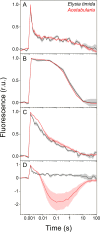

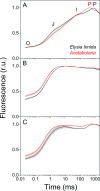

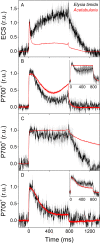
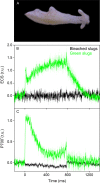
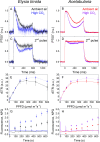

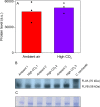
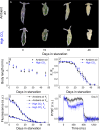
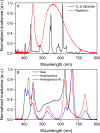


Comment in
-
On the art of stealing chloroplasts.Elife. 2020 Nov 20;9:e64057. doi: 10.7554/eLife.64057. Elife. 2020. PMID: 33215989 Free PMC article.
Similar articles
-
Food shaped photosynthesis: Photophysiology of the sea slug Elysia viridis fed with two alternative chloroplast donors.Open Res Eur. 2024 Mar 13;3:107. doi: 10.12688/openreseurope.16162.2. eCollection 2023. Open Res Eur. 2024. PMID: 38725452 Free PMC article.
-
Photoprotective mechanisms in Elysia species hosting Acetabularia chloroplasts shed light on host-donor compatibility in photosynthetic sea slugs.Physiol Plant. 2024 Mar-Apr;176(2):e14273. doi: 10.1111/ppl.14273. Physiol Plant. 2024. PMID: 38566156
-
The photon menace: kleptoplast protection in the photosynthetic sea slug Elysia timida.J Exp Biol. 2019 Jun 27;222(Pt 12):jeb202580. doi: 10.1242/jeb.202580. J Exp Biol. 2019. PMID: 31171599
-
Crawling leaves: photosynthesis in sacoglossan sea slugs.J Exp Bot. 2013 Oct;64(13):3999-4009. doi: 10.1093/jxb/ert197. Epub 2013 Jul 11. J Exp Bot. 2013. PMID: 23846876 Review.
-
Cell biology of the chloroplast symbiosis in sacoglossan sea slugs.Int Rev Cell Mol Biol. 2012;293:123-48. doi: 10.1016/B978-0-12-394304-0.00009-9. Int Rev Cell Mol Biol. 2012. PMID: 22251560 Review.
Cited by
-
Resistance induction and nematicidal activity of certain monoterpenes against tomato root-knot caused by Meloidogyne incognita.Front Plant Sci. 2022 Sep 20;13:982414. doi: 10.3389/fpls.2022.982414. eCollection 2022. Front Plant Sci. 2022. PMID: 36204064 Free PMC article.
-
Ultraviolet screening by slug tissue and tight packing of plastids protect photosynthetic sea slugs from photoinhibition.Photosynth Res. 2022 Jun;152(3):373-387. doi: 10.1007/s11120-021-00883-7. Epub 2021 Nov 26. Photosynth Res. 2022. PMID: 34826025 Free PMC article.
-
Kleptoplasty: Getting away with stolen chloroplasts.PLoS Biol. 2022 Nov 8;20(11):e3001857. doi: 10.1371/journal.pbio.3001857. eCollection 2022 Nov. PLoS Biol. 2022. PMID: 36346789 Free PMC article.
-
How to build a lichen: from metabolite release to symbiotic interplay.New Phytol. 2023 May;238(4):1362-1378. doi: 10.1111/nph.18780. Epub 2023 Mar 4. New Phytol. 2023. PMID: 36710517 Free PMC article. Review.
-
Loss of state transitions in Bryopsidales macroalgae and kleptoplastic sea slugs (Gastropoda, Sacoglossa).Commun Biol. 2025 Jun 5;8(1):869. doi: 10.1038/s42003-025-08305-3. Commun Biol. 2025. PMID: 40473784 Free PMC article.
References
-
- Antal TK, Matorin DN, Kukarskikh GP, Lambreva MD, Tyystjärvi E, Krendeleva TE, Tsygankov AA, Rubin AB. Pathways of hydrogen photoproduction by immobilized Chlamydomonas reinhardtii cells deprived of sulfur. International Journal of Hydrogen Energy. 2014;39:18194–18203. doi: 10.1016/j.ijhydene.2014.08.135. - DOI
-
- Bulychev AA, Cherkashin AA, Muronets EM, Elanskaya IV. Photoinduction of electron transport on the acceptor side of PSI in Synechocystis PCC 6803 mutant deficient in Flavodiiron proteins Flv1 and Flv3. Biochimica Et Biophysica Acta (BBA) - Bioenergetics. 2018;1859:1086–1095. doi: 10.1016/j.bbabio.2018.06.012. - DOI - PubMed
Publication types
MeSH terms
Substances
Grants and funding
LinkOut - more resources
Full Text Sources
Research Materials

